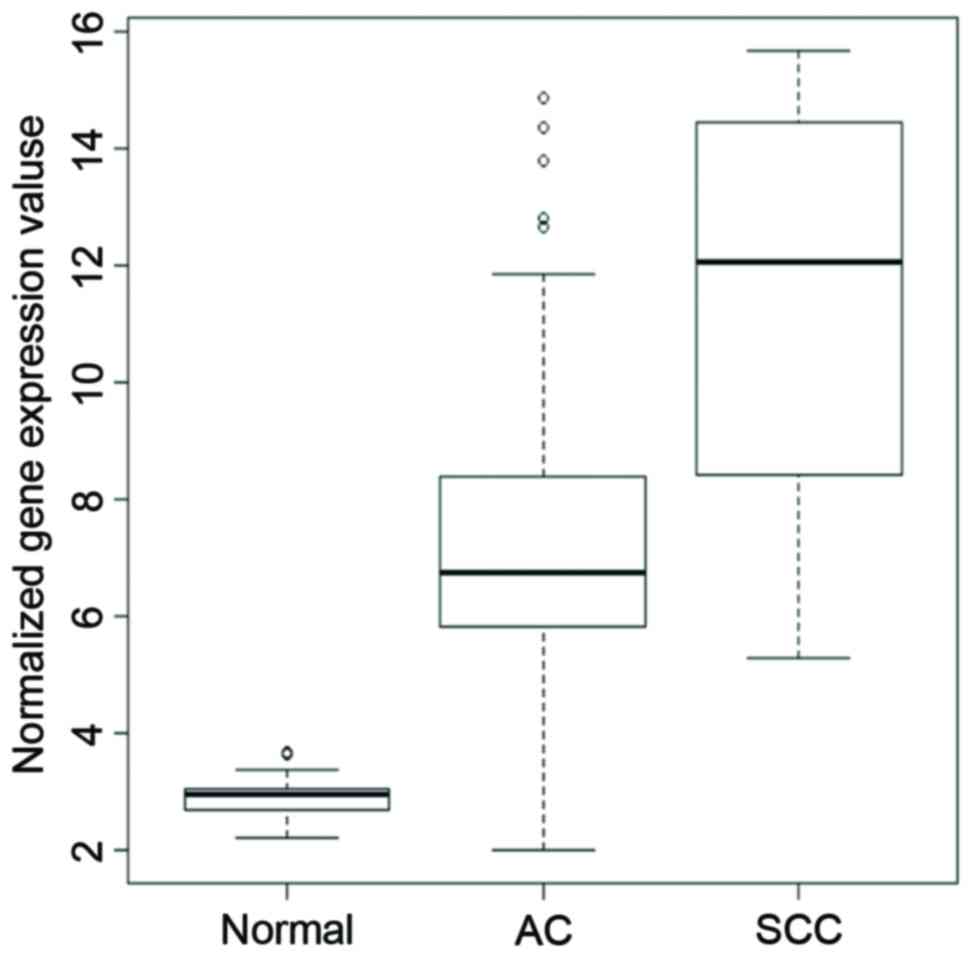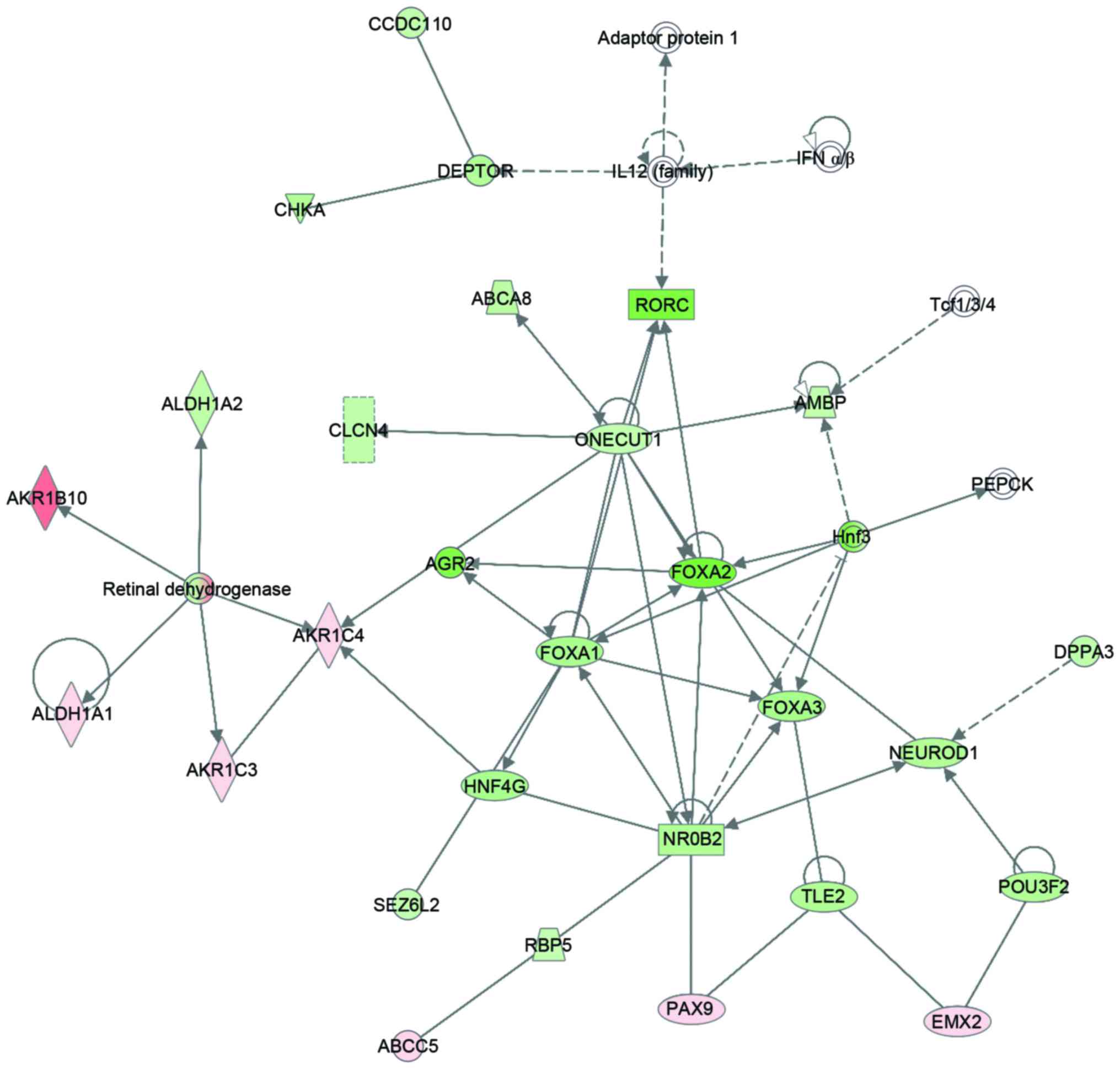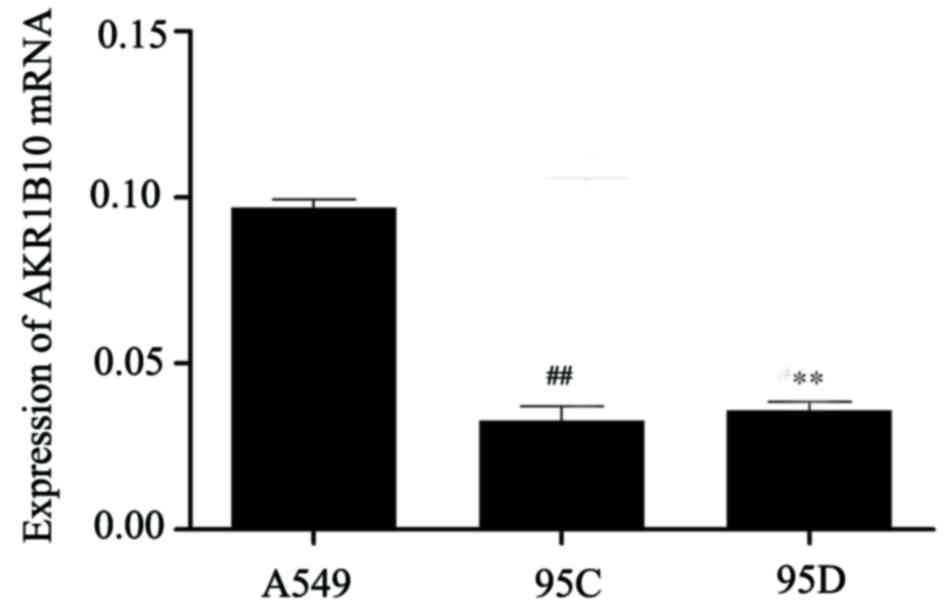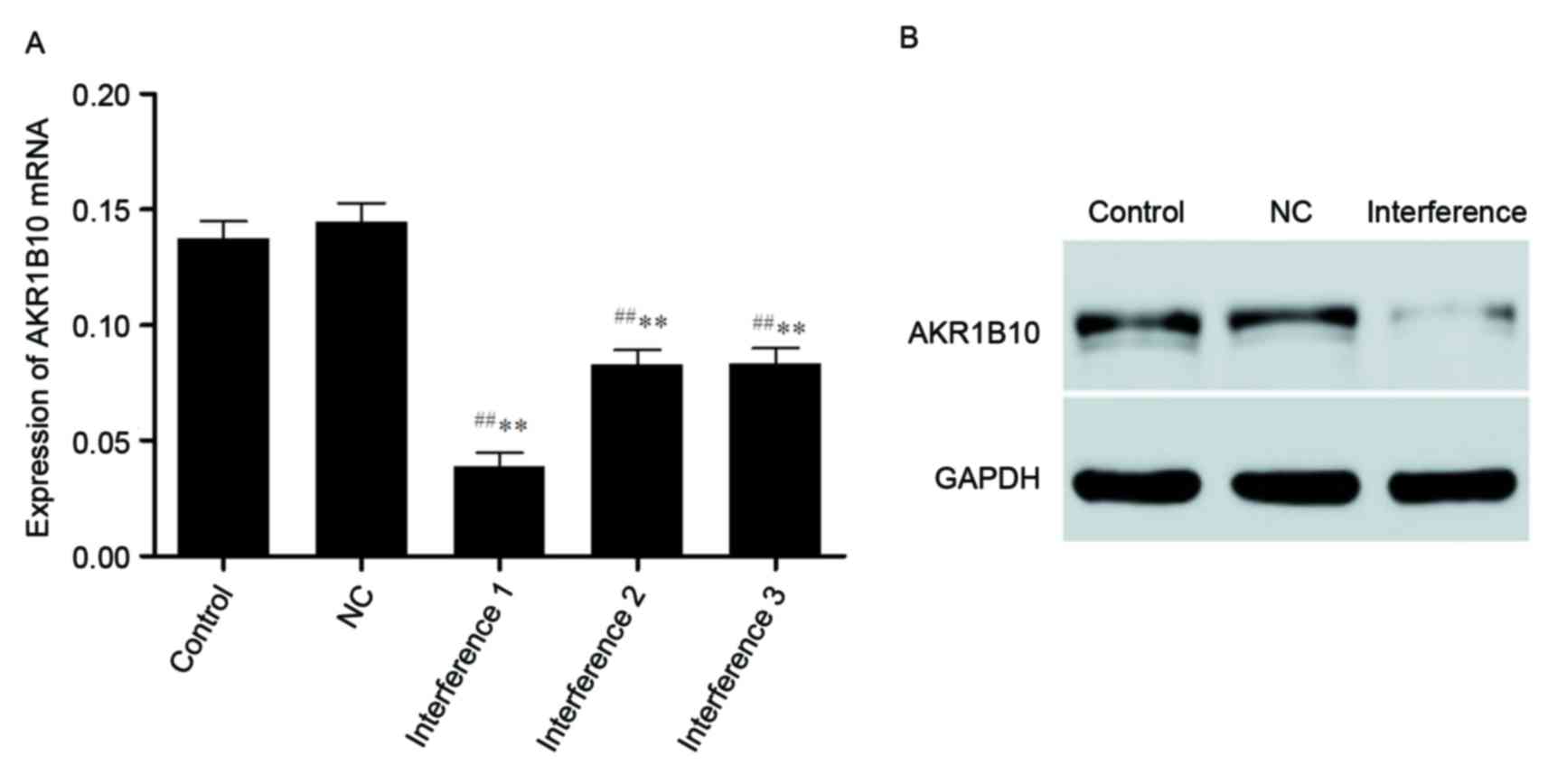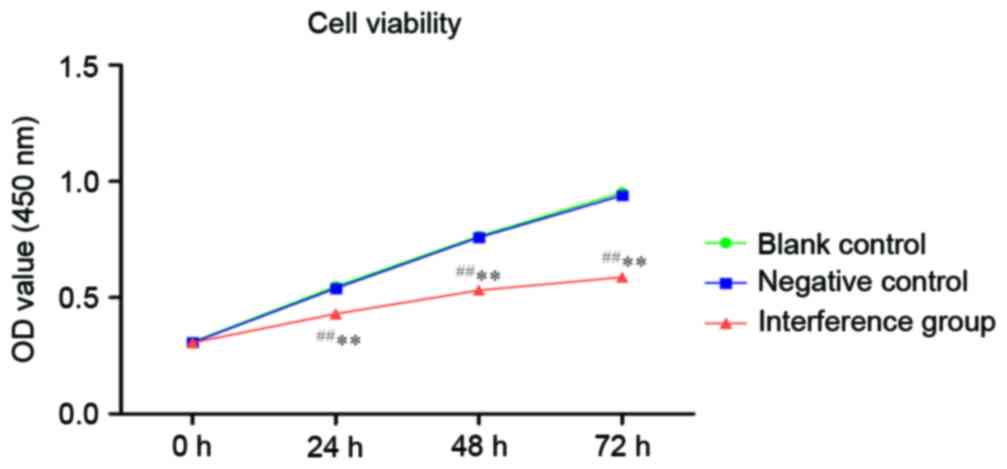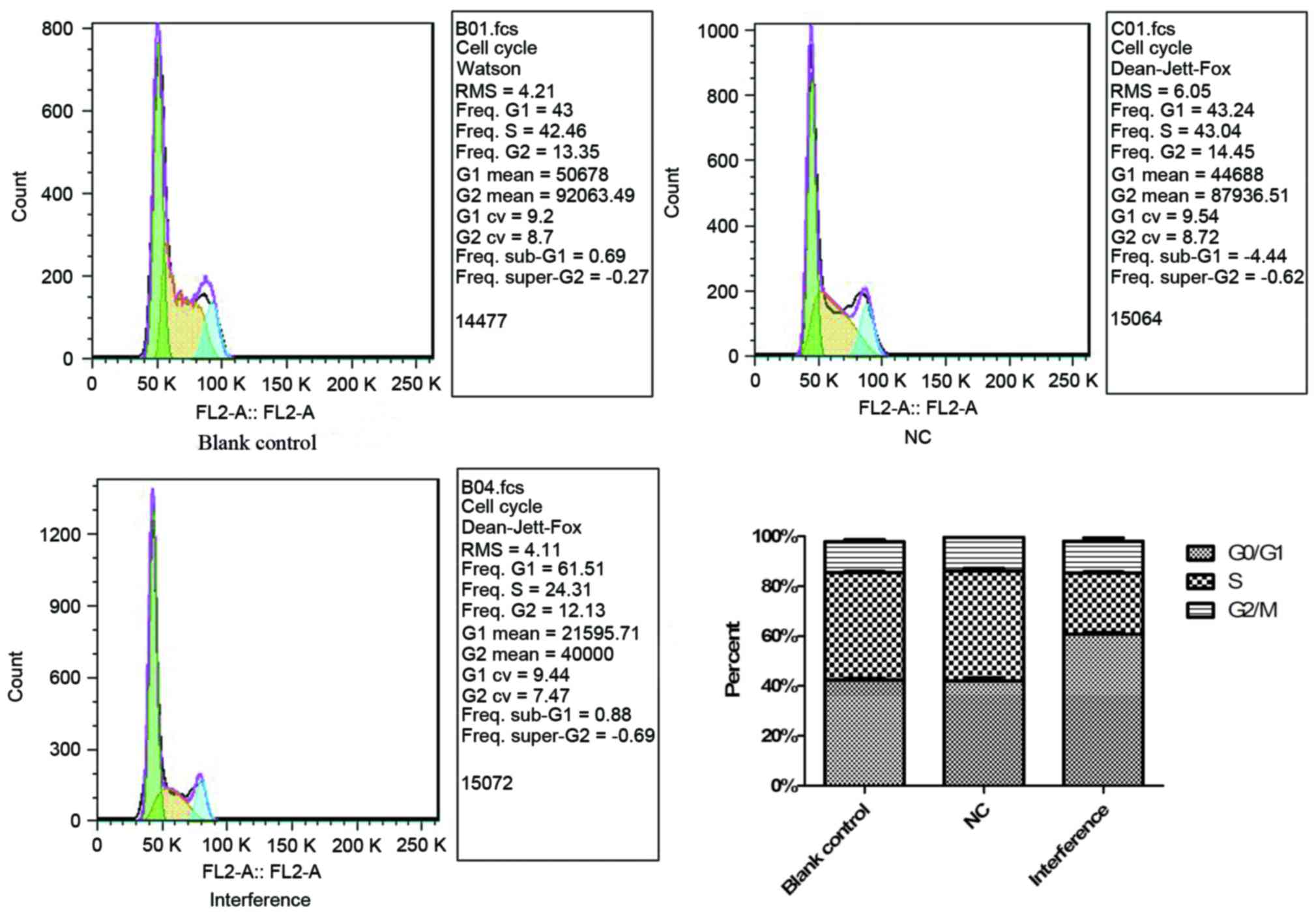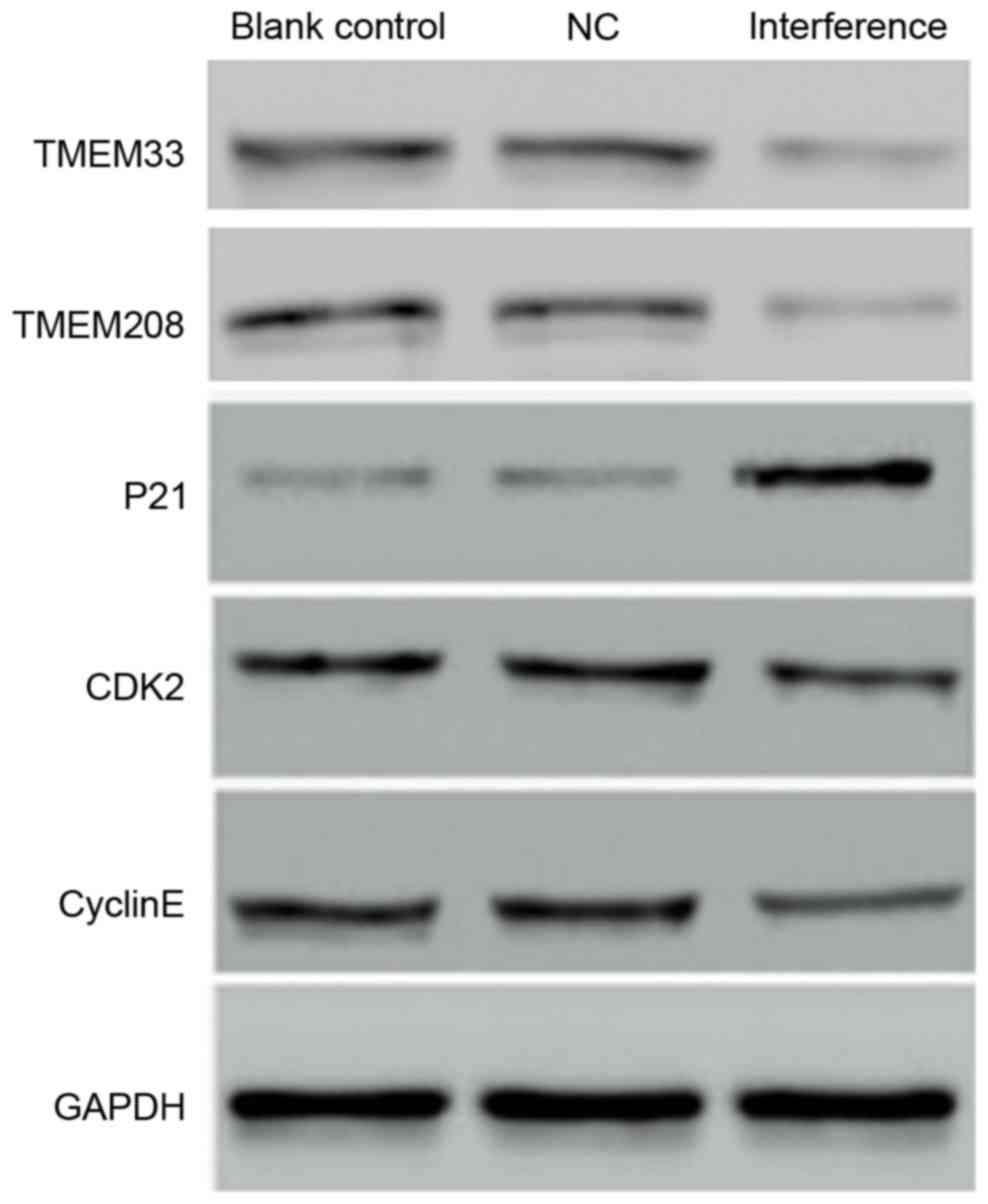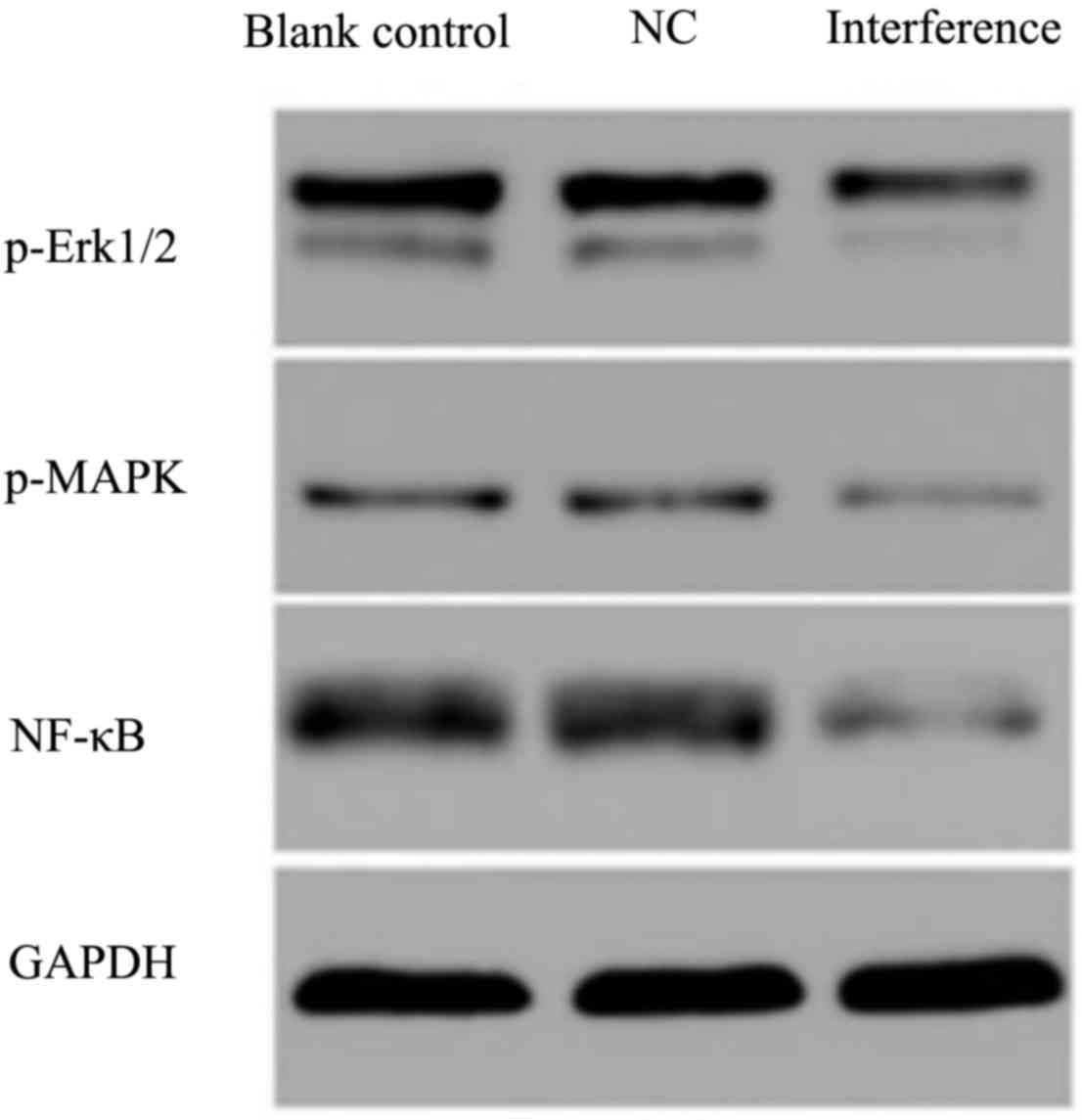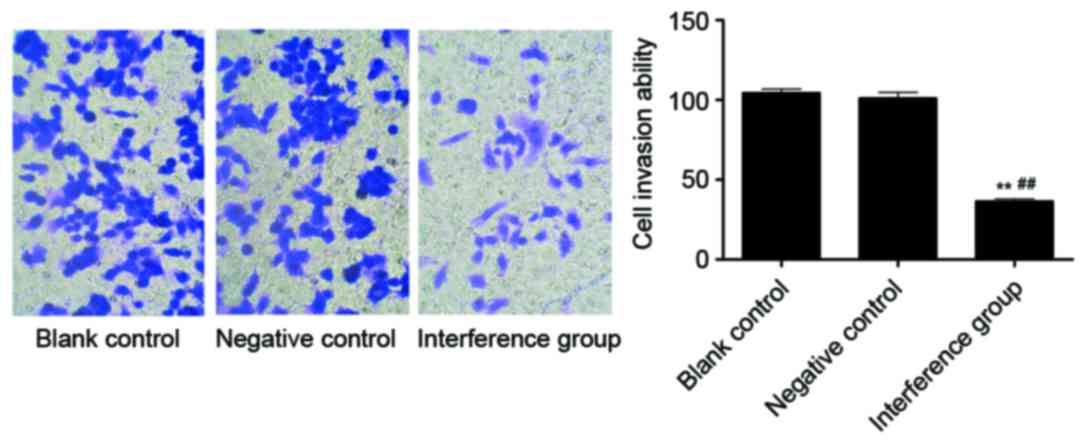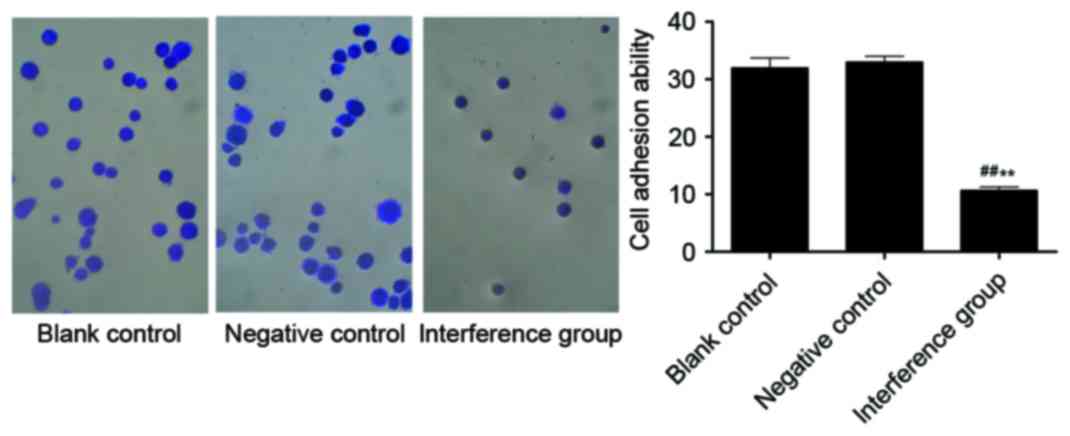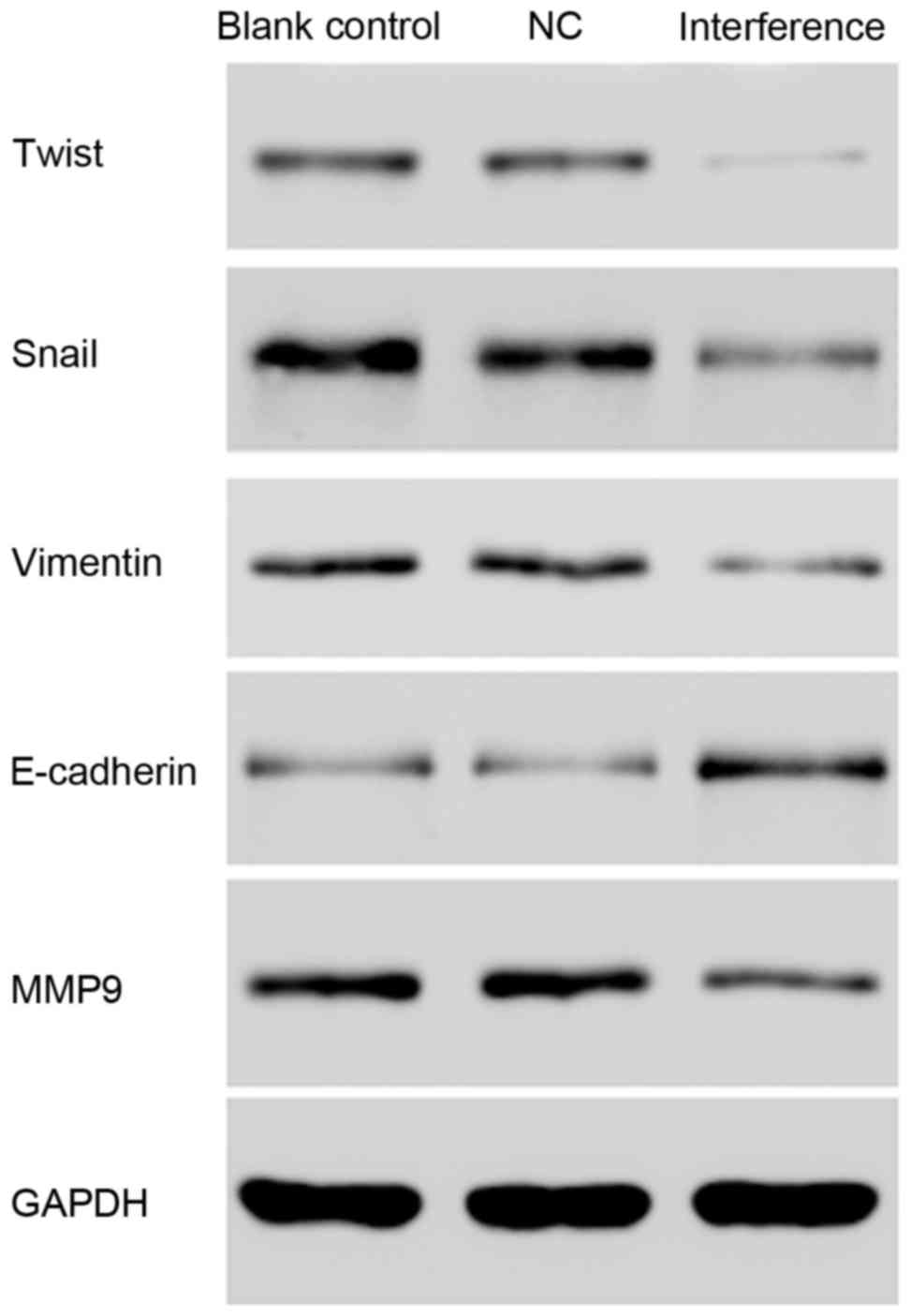Inhibiting proliferation and migration of lung cancer using small interfering RNA targeting on Aldo-keto reductase family 1 member B10
Retraction in: /10.3892/mmr.2023.13109
- Authors:
- Published online on: November 28, 2017 https://doi.org/10.3892/mmr.2017.8173
- Pages: 2153-2160
-
Copyright: © Zhou et al. This is an open access article distributed under the terms of Creative Commons Attribution License.
Abstract
Introduction
Lung cancer is the most common cancer in terms of both incidence and mortality worldwide. Non-small-cell lung carcinoma (NSCLC) accounts for at least 85% of all lung cancers, and often spreads beyond the initial tumor area at the time of diagnosis (1). Lung cancer has been well studied during the past decades (2,3). Current advances in genetics have identified various genes associated with NSCLC initiation and progression (4–6). Microarray and next-generation sequencing technology allows for a comprehensive view of both genetic alteration and gene expression profiling of lung cancer.
Aldo-keto reductase 1 B10 (AKR1B10, Aldo-keto reductase family 1. member B10, or aldose reductase. L, namely ARL.1), is a member of the human aldo-keto reductase (AKR) family. The expression of AKR1B10 is typically limited to the small intestine and colon in humans, serving a role in regulating cell proliferation and differentiation by modulating the metabolism of retinoids and prenylation of oncoproteins (7). AKR1B10 protein was successfully isolated from primary liver cancer tissues by Cao et al in 1998 (8), and Penning and Fukumoto demonstrated that it was overexpressed in liver cancer and lung cancer tissues (9,10). AKR1B10 is overexpressed in 84.4% of squamous cell carcinoma and in 29.9% of adenocarcinoma in smoking patients, and is closely associated with smoking in the NSCLC (9). The knockdown of AKR1B10 by small interfering RNA results in a reduction in cell proliferation in colorectal carcinoma HCT-8 cells (7). Previous studies demonstrated that AKR1B10 mRNA over-expression was associated with male gender, smoking, squamous cell carcinoma and moderate or poor cell differentiation (11). In addition, AKR1B10 participates in the development of some tumor cells and the carcinogenic process, which influences the survival and growth of tumor tissue (12). However, the mechanisms of invasion and migration of lung cancer cells mediated by AKR1B10 remain unclear. In the present study, this mechanism was explored.
In the present study, two public lung cancer gene expression data were analyzed, in which the AKR1B10 gene was significantly up regulated in the lung cancer tissues compared with the normal ones. The overexpression of AKR1B10 in lung cancer indicated the important role of AKR1B10 in lung cancer. Additionally, the expression level of AKR1B10 in lung cancer cells was modified and the role of AKR1B10 in lung cancer proliferation and apoptosis was investigated. Silencing of AKR1B10 was demonstrated to inhibit proliferation and increase apoptosis of lung cancer cell lines. These results suggested that AKR1B10 serves an important role in lung cancer.
Materials and methods
Materials
The A549, 95C, 95D and 293T lung adenocarcinoma cancer cell lines were obtained from the tumor research institute of Shanghai Chest Hospital (Shanghai, China). TRIzol was used as RNA extraction reagent (Invitrogen; Thermo Fisher Scientific Inc., Waltham, MA, USA); dimethyl pyrocarbonate-treated water was produced by Jrdun Biotechnology (Shanghai, China); chloroform, isopropyl alcohol and anhydrous ethanol were the products of Sinopharm Chemical Reagent Co., Ltd (Shanghai, China); LA Taq enzyme and DNA marker were purchased from Takara Bio Inc. (Otsu, Japan); T4 DNA Ligase restriction enzymes were from Thermo Fisher Scientific Inc.; DH5α competent cells and High Pure deoxynucleotides from Transgene Biotech; a plasmid extraction kit was from Omega Bio-Tek, Inc. (Norcross, GA, USA); agarose gel DNA fragment recovery kit was from Beijing Solarbio Science & Technology Co., Ltd. (Beijing, China); a liposomal transfection kit was from Invitrogen; Thermo Fisher Scientific, Inc.; pLKO.1-EGFP (lentivirus core plasmid) was from Changsha Yingrun Biotechnology Co., Ltd. (Changsha, China); psPAX2, PMD2. G (lentivirus packaging plasmid) was from Addgene Inc. (Cambridge, MA, USA); 293T cell and a Cell Counting kit-8 (CCK-8) was from Dojindo Molecular Technologies, Inc. (Kumamoto, Japan), and an Annexin V apoptosis detection kit was from BD Biosciences (Franklin Lakes, NJ, USA). Cells were observed by Dsy5000× inverted microscope (Roctec Technology Co., Ltd, Xi'an, China).
Whole transcriptome analysis and differentially expressed genes (DEGs) analysis in the lung cancer public data
To investigate the gene expression alteration in different lung cancer types, the present study downloaded the microarray dataset from the National Center for Biotechnology Information Gene Expression Omnibus (GEO) data repository (www.ncbi.nlm.nih.gov/geo/). The GSE43580 (13) and GSE40588 datasets include 60 noncancerous lung tissues adjacent to lung squamous cell carcinoma (SCC) tissues, 77 lung adenocarcinoma and 73 lung SCC tissues. Gene expression profiles of each tissue sample were obtained using the Affymetrix Human Genome U133 Plus 2.0 microarrays (HG-U133A; Affymetrix; Thermo Fisher Scientific, Inc.). The raw data were normalized using the limma package in Bioconductor (version 3.5; https://www.bioconductor.org/) with default settings. Fold change of gene expression and corresponding t-test P values were calculated between AC and SCC groups. DEGs were defined as the genes that met the criteria of a fold change value >1.5 and had a P-value <0.05. All identified DEGs were used to perform Ingenuity pathway analysis (IPA).
Cell culture
The A549, 95C, 95D and 293T non-small cell lung cancer cell lines were cultured in RPMI 1640 medium (Sigma-Aldrich; Merck KGaA, Darmstadt, Germany) with 10% fetal bovine serum (FBS), 100 U/ml penicillin and 100 U/ml streptomycin. Cells were maintained at 37°C under an atmosphere of 95% air and 5% CO2.
Reverse transcription-quantitative polymerase chain reaction (RT-qPCR) to detect the expression of AKR1B10 in lung cancer cell lines
Total RNA extraction of cells was prepared with TRIzol. Each sample with 200 ng total RNA were subjected to cDNA reverse transcription and qPCR analysis with the SYBR Green, PCR kit and RT kit (Thermo Fisher Scientific, Inc.). The quantity and quality of RNA were confirmed with a NanoDrop 1000 (Thermo Fisher Scientific, Inc.). The primers used to detect AKR1B10 mRNA were (forward), 5′-CCCAGGTTCTGATCCGTTTC-3′ and (reverse), 5′-GGTTGCCATCTCCTCATCAC-3′ (Generay Biotech Co., Ltd., Shanghai, China). RT was performed at 50°C for 30 min. PCR conditions were as follows: Denaturing at 95°C for 10 min, followed by 40 cycles of 95°C for 15 sec, 60°C for 1 min, 95°C for 15 sec and 60°C for 15 sec. The expression of AKR1B10 was normalized to that of GAPDH (forward, 5′CAC CCA CTC CTC CAC CTT TG3′ and reverse, 5′CCA CCA CCC TGT TGC TGT AG3′. mRNA levels were quantified using the 2−ΔΔCq method and normalized to the internal reference gene GAPDH (14). Data were analyzed by ABI Prism 7300 SDS Software (version 1.3.1, Applied Biosystems; Thermo Fisher Scientific Inc.).
Plasmids and transfections
For lentiviral transduction, 2.5×106 of 293T cells were plated in 10-cm plates and transfected 24 h later with DNA from lentiviral backbone vector and plasmids [PLKO.1-AKR1B10-green fluorescent protein (GFP), 1,000 µg; psPAX2, 900 µg; pMD2G, 100 µg] and Lipofection® 2000 (Invitrogen; Thermo Fisher Scientific, Inc.). Medium was changed to RPMI 1640 at 24 h post-transfection, and the viral supernatant was harvested and filtered 49 h post-transfection.
A549 cells (5×105/ml) were infected for 24 h as follows: 2 µl PBS was added into the blank control group, the negative control group (NC) was infected with 2 µl empty lentivirus (virus titer 1×109 IU/ml), and the interference group was infected with 2 µl lentivirus containing AKR1B10-small hairpin (sh)RNA with three different candidate loci (virus titer 1×109 IU/ml) and 6 µg/ml polybrene (Sigma Aldrich; Merck KGaA, Darmstadt, Germany), in 6-well culture dishes. Cells were screened 48 h post-transduction by Fluorescence-Activated Cell Sorting (FACS) for GFP-positive cells (conditions as in cell cycle analysis). To normalize the transfection efficiency, cells were digested by trypsin and frozen in liquid nitrogen for the follow-up AKR1B10 silencing experiment.
Cell proliferation assay
Cell proliferation was assessed by CCK-8 assay. Briefly, cells were harvested 48 h after infection by lentivirus. Subsequently, the infected cells were seeded on 96-well microplate at a density of 3×103 cells per well. The cells were cultured for 24, 48 and 72 h at 37°C. Finally, 10 µl CCK-8 solution was added to each well, and cells were incubated for an additional 3 h at 37°C. Optical density (OD) was determined at a wavelength of 450 nm.
Apoptosis analysis
The effect of siRNA-AKR1B10 on the apoptosis of A549 cells was evaluated by flow cytometry using the Annexin V phycoerythin (PE) Apoptosis kit (BD Pharmingen; BD Biosciences). Firstly, A549 cells (5~10)x104, were infected with lentivirus (siRNA, vector and control) and treated with EDTA-free trypsin (Sigma-Aldrich; Merck KGaA) for 72 h at 37°C. Afterwards, cells were washed with 1X PBS (4°C), followed by resuspension of the cell pellet with 300 µl 1X Binding Buffer (BD Pharmingen; BD Biosciences). Next, 5 µl Annexin V-PE was added to the cell suspension for 15 min in the dark at room temperature, according to the manufacturer's protocol. A total of 5 µl of 7-AAD solution was added in the cell suspension 5 min prior to flow cytometry analysis, and then 200 µl 1× Binding Buffer was added for flow cytometry analysis. The percentage of apoptotic cells was evaluated by BD CellQuest (version 5.1; BD Biosciences).
Cell cycle analysis
After transfection for 48 h at 37°C, the cells of different groups were digested with 0.25% trypsin into single cells, and subsequently the cell suspension was collected to the special pipe of flow cytometry. After 1,000 × g centrifugation for 5 min at 37°C, the precipitate was re-suspended with 300 µl PBS containing 10% FBS, and then transferred into a 1.5 ml centrifugal tube; 700 µl anhydrous ethanol was added into the samples to fix cells at −20°C for 24 h. Fixed samples were then centrifuged at 3,000 × g for 30 sec at 4°C. The precipitate was washed with 1 ml pre-cooled PBS buffer twice and was re-suspended with 100 µl 1 mg/ml RNase A solution at 37°C to digest the intracellular RNA; 400 µl 50 µg/ml propidium iodide (PI) solution was added for 10 min at 37°C for nuclear dyeing in the dark. The percentage of cells in phase of cell cycle were determined by FACSCalibur (BD Biosciences).
Western blotting
Total proteins were extracted from A549 cells after transfection for 48 h using lysis buffer (Beyotime Institute of Biotechnology, Haimen, China) at 37°C, protein concentration was determined by bicinchoninic acid assay (Beyotime Institute of Biotechnology) and were separated on a 10% SDS-PAGE gel with 30 µg/lane. Proteins were transferred to polyvinylidene difluoride membranes, The membranes were incubated with AKR1B10 (ab192165; 1:1,000), Twist (ab175430; 1:1,000), Vimentin (ab16700; 1:1,000), matrix metalloprotease (MMP) 9 (ab119906; 1:1,000), transmembrane protein (TMEM) 33 (ab118435; 1:1,000) and 208 (ab126292; 1:1,000), P21 (ab109199; 1:1,000), cyclin-dependent kinase (CDK) 2 (ab32147; 1:1,000), Cyclin E (ab3927; 1:500; all from Abcam, Cambridge, MA, USA), Snail (CST#3879; 1:1,000), E-cadherin (CST#14,472; 1:1,000), phosphorylated (P)-extracellular regulated kinase (Erk) 1/2 (CST4376; 1:1,000), P-mitogen-activated protein kinase (P-MAPK) (CST4511; 1:1,000) and P-nuclear factor (NF)-κB (CST13346, 1:1,000; all from Cell Signaling Technology, Inc., Danvers, MA, USA) for 1 h at 37°C. The membranes were incubated in horseradish peroxidase-conjugated polyclonal anti-rabbit secondary antibodies (1:5,000, Abcam) for 1 h at 37°C. Proteins were visualized by Thermo Pierce ECL (Thermo Fisher Scientific Inc.). To ascertain equivalent loading of the lanes, blots were normalized and incubated with an anti-GAPDH antibody (ab9485; 1:2,000; Abcam).
Cell invasion ability
A549 cells (5×105) were infected with siRNA-AKR1B10 for 24 h at 37°C, and seeded into Matrigel-plated upper wells (5×104/well), while 500 µl complete medium was added to the lower wells. Following incubation for 48 h at 37°C, each upper well was cleared by swabs and lower well were measured by CCK-8 assay for 2 h at 37°C. A BIO-TEK MQX200 Universal Microplate Reader (Bio-Tek) was used to detect the absorbance at 450 nm.
Cell adhesive ability
A549 cells (5×105/ml) were infected for 24 h and were seeded on 12-well plates (105/well) with BDTM Fibronectin (BD Biosciences). Cell suspensions were rapidly poured into each well. Cells were allowed to adhere for 1 h at 37°C in humidified air with 5% CO2. Cells were observed using an inverted microscope (Dsy5000x).
Statistical analysis
GraphPad Prism 5 was used to perform all statistical analysis. Dara are presented as the mean ± standard deviation. Significance between groups was evaluated by one way analysis of variance followed by a Bonferroni post hoc test. P<0.05 was considered to indicate a statistically significant difference.
Results
Whole transcriptome profiling reveals gene expression differences of AKR1B10 expression between normal and lung cancer tissues
In order to reveal the AKR1B10 gene expression in lung cancer, the public lung cancer dataset in NCBI Gene Expression Omnibus (GEO) was analyzed which includes 60 noncancerous lung tissues adjacent to lung SCC, 77 lung adenocarcinomas and 73 lung squamous cell carcinoma tissues. As depicted in Fig. 1, differential AKR1B10 gene expression was observed among normal, AC and SCC tissues. Compared with the normal tissues, expression of AKR1B10 gene increased 3.9 folds in lung adenocarcinoma tissues (P<5.25e−24). Expression of AKR1B10 was significantly higher in SCC, which was 2.1-fold higher than the AC group, (P<1.26e−13). In addition, differential expression analysis was performed to reveal the whole-transcriptome profiling alteration between SCC and AC. Totally, 2648 differently expressed genes were identified. As demonstrated in Fig. 2, IPA pathway and network analysis revealed that the AKR1B10 was involved in a cancer metabolism network.
Expression of AKR1B10 in different lung adenocarcinoma cell lines
The expression levels of AKR1B10 mRNA in A549, 95C and 95D cell lines were examined by RT-qPCR (Fig. 3). Collectively, the expression of AKR1B10 was much higher in A549 cells than the other two cell lines. Therefore, A549 cell lines were selected for subsequent interference experiments.
Expression of AKR1B10 mRNA following transfection in A549 cells
RT-qPCR results demonstrated that Site 1 was the best interference locus of the A549 cell line to form a stable A549-shRNAi strain among the three candidate loci. AKR1B10 mRNA expressions of the blank control group, the negative control group (NC) and the interference group shows that all three interference groups and the negative control group had statistically significance difference (P<0.01) but there was no difference between blank control group and the NC group (P>0.05), suggesting that shRNA had successfully interfered the expression of AKR1B10. A similar trend in western blotting was demonstrated, and the lentivirus had no significant effect on the expression of AKR1B10 mRNA (Fig. 4).
Cell proliferation of A549 after AKR1B10 gene silencing
As illustrated in Fig. 5, the OD450 values of each group indicated that the control group had no significant difference (P>0.05) with the NC group. At the same time, the OD450 values of the interference group indicated a statistically significant difference (P<0.01) with the negative control group.
Effects on the cell cycle of A549 cells following AKR1B10 gene silencing
The cell cycle array by flow cytometry in Fig. 6 indicated that cell proliferation of interference group was reduced due to the delay of G0/G1 phase. Furthermore, CDK2 and Cyclin E protein levels were down-regulated in the interference group, while P21 was upregulated (Fig. 7). This may imply that the upregulation of P21 enhanced the inhibition of the CyclinE-CDK2 complex leading to a delay in the G0/G1 phase. In addition, TMEM33 and TMEM208, both of which are involved in the endoplasmic reticulum stress and autophagy, were down-regulated.
Effects on the cell apoptosis of A549 cells following AKR1B10 gene silencing
Apoptosis rate (%) of the blank control, the NC and the interference group were 2.87±0.21, 2.90±0.10 and 27.73±0.23, respectively. The interference group presented the highest apoptosis rate and had a significant difference from the NC and the blank control group (P<0.01; Fig. 8).
Effects on the ERK/MAPK signaling pathway following AKR1B10 gene silencing
Proteins of the ERK/MAPK signaling pathway were determined by western blotting and results demonstrated that the expression of P-ERK and MAPK decreased after AKR1B10 gene silencing (Fig. 9). The phosphorylation of upstream kinase could activate the downstream kinases, and activate the downstream nuclear transcription factor (NF)-κB at the nucleus. In addition, ERK can activate NF-κB indirectly by phosphorylation. P-NF-κB was also tested, and was also down-regulated after the AKR1B10 gene silencing.
Effects on the cell invasion ability following AKR1B10 silencing in A549 cells
The Transwell results indicated that the cell invasion ability of the interference group was significantly lower compared with the blank control group, as well as with the NC group (P<0.01). Between the blank control and the NC group there was no significant difference (Fig. 10).
Effects on cell adhesion following AKR1B10 gene silencing in A549 cells
The cell adhesion experiments indicated that the adhesive ability of the interference group was notably decreased compared with the other two groups (P<0.01). Between the blank control and the NC groups there was no significant difference (Fig. 11).
Cell migration and invasion assays
As demonstrated in Fig. 12, silencing of AKR1B10 by shRNA led to down-regulation of Snail, Twist, Vimentin, and MMP9, and upregulation of E-cadherin, which may indicate that AKR1B10 gene silencing may inhibit the invasion and metastasis of tumor cells.
Discussion
With the development of precision medicine, epidermal growth factor receptor gene mutation and ALK tyrosine kinase receptor gene fusion have become important therapeutic targets, and the nonsmoking adenocarcinoma patients can benefit from them. However, at present there is no clear targeted drug for heavily-smoking patients with squamous carcinoma. In the present study, two public lung cancer datasets were analyzed, containing gene expression profiles of AC, SCC and para tumor tissues of lung cancer. Data analysis revealed that the gene expression of AKR1B10 was significantly up regulated in AC and SCC compared with normal tissues. In addition, an AKR1B10 network was also detected, indicating an important role in AC and SCC.
Previous studies have focused on the association between the function of AKR1B10 and its molecular function participating in cell biology (15–17). AKR1B10 defends normal cells through anti-carbonyl mechanism (18). The effects of AKR1B10 on cell proliferation, clone formation and cell sensitivity to acrolein and crotonaldehyde suggest the protection from carbonyl toxicity (19). AKRlB10 has strong enzymatic activity for all-trans-retinal, 9-cis-retinal, and 13-cis-retinal, which catalyzes them into the metabolized retinols (vitamin A) (20). Retinoic acid is a critical signal molecular regulating cell proliferation and differentiation (19). A previous study revealed that AKR1B10 adjusts the cell membrane lipid second messenger through alteration of the stability of acetyl-CoA, affecting the synthesis of long chain fatty acid which is essential in cell proliferation and division (21).
The present study investigated and identified inhibition of the cell cycle, cell proliferation, and cell adhesion and migration of A549 lung carcinoma cells following AKR1B10 RNA interference. In the present study, the inhibition was associated with the increase of A549 cells apoptosis through the autophagy pathway. Western blot analysis results demonstrated that transmembrane proteins TMEM33 and TMEM208 were down regulated in the interference group, probably due to the autophagy at the condition of endoplasmic reticulum stress. It was also demonstrated that the epithelial-mesenchymal transition-associated proteins, such as Snail, Twist, Vimentin and MMP9 were down-regulated after AKR1B10 gene silencing, whereas the expression of E-cadherin was upregulated, indicating that AKR1B10 gene silencing effectively inhibits the invasion and metastasis of tumor cells. Invasion and migration of lung cancer cells are hallmarks of lung malignancy, and usually illustrate poor prognosis and treatment failure. The present study used a Transwell assay to demonstrate that the highly expressed AKR1B10 in A549 human lung adenocarcinoma cells caused stronger invasive ability, and when AKR1B10 was knocked down this ability was significantly suppressed. Furthermore, the metastasis mechanism of lung cancer cells is not only associated with the invasive ability, but also with the cell adhesion ability. Dynamic changes of the adhesion ability results in the phenomic change of motion, migration and invasion of tumor cells. The present study confirmed the strong adhesion ability of the highly expressed AKR1B10 in A549 lung adenocarcinoma cells, and when AKR1B10 was knocked down the adhesion of A549 cells was inhibited.
Cell cycle control is one of the major regulatory mechanisms of cell growth, which has been widely used to arrest the cell cycle at a specific checkpoint in many anti-cancer drugs. The eukaryotic cell division cycle is mainly regulated by the cyclin/CDK complex; inhibition of this complex results in down regulation of the cell cycle. The AKR1B10 gene silencing of the A549 cell line caused a delay of the cell cycle at the G0 to G1 phase. Also, P21 is a CDK inhibitor that halters the cell cycle by directly binding to cyclins and CDKs (22). Previous studies have demonstrated that P21 can induce either G1 arrest or cell death (23). In the present study, CDK2 and Cyclin E were down-regulated in the interference group, while P21 was upregulated by western blotting, implying that the overexpression of P21 enhanced the inhibition of the CyclinE-CDK2 complex and led to the G0/G1 phase arrest. Finally, inhibition of the ERK1/2 MAPK signaling pathway may lead to a decrease in cyclin D1 expression and inhibition of cell cycle progression (24). The ERK signaling pathway, is regarded as the most classic pathway of the MAPKs pathways (25), and serves an important role in tumor cell proliferation, differentiation, apoptosis, migration, and angiogenesis. In this study, the expression of P-ERK and MAPK were observed to decrease after AKR1B10 gene silencing which is consistent with previous studies (7,26).
In conclusion, AKR1B10 was upregulated in the lung cancer tissues from two public lung cancer gene expression data compared with the control groups. Previous studies have demonstrated that the expression of AKR1B10 is associated with cell proliferation, cell cycle, adhesion and invasion, as well as with the ERK/MAPK signaling pathway. The overexpression of AKR1B10 in lung cancer tissues indicates the important role of AKR1B10 in tumorigenesis which provides a potential diagnosis and treatment biomarker for lung cancer.
References
|
Torre LA, Bray F, Siegel RL, Ferlay J, Lortet-Tieulent J and Jemal A: Global cancer statistics, 2012. CA Cancer J Clin. 65:87–108. 2015. View Article : Google Scholar : PubMed/NCBI | |
|
Hensing T, Chawla A, Batra R and Salgia R: A personalized treatment for lung cancer: Molecular pathways, targeted therapies, and genomic characterization. Adv Exp Med Biol. 799:85–117. 2014. View Article : Google Scholar : PubMed/NCBI | |
|
Nanavaty P, Alvarez MS and Alberts WM: Lung cancer screening: Advantages, controversies, and applications. Cancer Control. 21:9–14. 2014. View Article : Google Scholar : PubMed/NCBI | |
|
Gainor JF, Tan DS, De Pas T, Solomon BJ, Ahmad A, Lazzari C, de Marinis F, Spitaleri G, Schultz K, Friboulet L, et al: Progression-free and overall survival in Alk-positive NSCLC patients treated with sequential crizotinib and ceritinib. Clin Cancer Res. 21:2745–2752. 2015. View Article : Google Scholar : PubMed/NCBI | |
|
Liu C, Shi X, Wang L, Wu Y, Jin F, Bai C and Song Y: SUZ12 is involved in progression of non-small cell lung cancer by promoting cell proliferation and metastasis. Tumour Biol. 35:6073–6082. 2014. View Article : Google Scholar : PubMed/NCBI | |
|
Zhang FQ, Yang WT, Duan SZ, Xia YC, Zhu RY and Chen YB: JAK2 inhibitor TG101348 overcomes erlotinib-resistance in non-small cell lung carcinoma cells with mutated EGF receptor. Oncotarget. 6:14329–14343. 2015. View Article : Google Scholar : PubMed/NCBI | |
|
Nishinaka T, Miura T, Sakou M, Hidaka C, Sasaoka C, Okamura A, Okamoto A and Terada T: Down-regulation of aldo-keto reductase AKR1B10 gene expression by a phorbol ester via the ERK/c-Jun signaling pathway. Chem Biol Interact. 234:274–281. 2015. View Article : Google Scholar : PubMed/NCBI | |
|
Cao D, Fan ST and Chung SS: Identification and characterization of a novel human aldose reductase-like gene. J Biol Chem. 273:11429–11435. 1998. View Article : Google Scholar : PubMed/NCBI | |
|
Penning TM: AKR1B10: A new diagnostic marker of non-small cell lung carcinoma in smokers. Clin Cancer Res. 11:1687–1690. 2005. View Article : Google Scholar : PubMed/NCBI | |
|
Fukumoto S, Yamauchi N, Moriguchi H, Hippo Y, Watanabe A, Shibahara J, Taniguchi H, Ishikawa S, Ito H, Yamamoto S, et al: Overexpression of the aldo-keto reductase family protein AKR1B10 is highly correlated with smokers' non-small cell lung carcinomas. Clin Cancer Res. 11:1776–1785. 2005. View Article : Google Scholar : PubMed/NCBI | |
|
Kang MW, Lee ES, Yoon SY, Jo J, Lee J, Kim HK, Choi YS, Kim K, Shim YM, Kim J and Kim H: AKR1B10 is associated with smoking and smoking-related non-small-cell lung cancer. J Int Med Res. 39:78–85. 2011. View Article : Google Scholar : PubMed/NCBI | |
|
Chung YT, Matkowskyj KA, Li H, Bai H, Zhang W, Tsao MS, Liao J and Yang GY: Overexpression and oncogenic function of aldo-keto reductase family 1B10 (AKR1B10) in pancreatic carcinoma. Mod Pathol. 25:758–766. 2012. View Article : Google Scholar : PubMed/NCBI | |
|
Tarca AL, Lauria M, Unger M, Bilal E, Boue S, Kumar Dey K, Hoeng J, Koeppl H, Martin F, Meyer P, et al: Strengths and limitations of microarray-based phenotype prediction: Lessons learned from the IMPROVER diagnostic signature challenge. Bioinformatics. 29:2892–2899. 2013. View Article : Google Scholar : PubMed/NCBI | |
|
Livak KJ and Schmittgen TD: Analysis of relative gene expression data using real-time quantitative PCR and the 2(-Delta Delta C(T)) method. Methods. 25:402–408. 2001. View Article : Google Scholar : PubMed/NCBI | |
|
Huang C, Verhulst S, Shen Y, Bu Y, Cao Y, He Y, Wang Y, Huang D, Cai C, Rao K, et al: AKR1B10 promotes breast cancer metastasis through integrin α5/δ-catenin mediated FAK/Src/Rac1 signaling pathway. Oncotarget. 7:43779–43791. 2016. View Article : Google Scholar : PubMed/NCBI | |
|
Zemanova L, Hofman J, Novotna E, Musilek K, Lundova T, Havrankova J, Hostalkova A, Chlebek J, Cahlikova L and Wsol V: Flavones inhibit the activity of AKR1B10, a promising therapeutic target for cancer treatment. J Nat Prod. 78:2666–2674. 2015. View Article : Google Scholar : PubMed/NCBI | |
|
Cao Z, Zhou B, Chen X, Huang D, Zhang X, Wang Z, Huang H, Wang Y and Cao D: Statil suppresses cancer cell growth and proliferation by the inhibition of tumor marker AKR1B10. Anticancer Drugs. 25:930–937. 2014. View Article : Google Scholar : PubMed/NCBI | |
|
Balendiran GK, Martin HJ, El-Hawari Y and Maser E: Cancer biomarker AKR1B10 and carbonyl metabolism. Chem Biol Interact. 178:134–137. 2009. View Article : Google Scholar : PubMed/NCBI | |
|
Huang L, He R, Luo W, Zhu YS, Li J, Tan T, Zhang X, Hu Z and Luo D: Aldo-Keto reductase family 1 member B10 inhibitors: Potential drugs for cancer treatment. Recent Pat Anticancer Drug Discov. 11:184–196. 2016. View Article : Google Scholar : PubMed/NCBI | |
|
Zhong L, Liu Z, Yan R, Johnson S, Zhao Y, Fang X and Cao D: Aldo-keto reductase family 1 B10 protein detoxifies dietary and lipid-derived alpha, beta-unsaturated carbonyls at physiological levels. Biochem Biophys Res Commun. 387:245–250. 2009. View Article : Google Scholar : PubMed/NCBI | |
|
Ma J, Yan R, Zu X, Cheng JM, Rao K, Liao DF and Cao D: Aldo-keto reductase family 1 B10 affects fatty acid synthesis by regulating the stability of acetyl-CoA carboxylase-alpha in breast cancer cells. J Biol Chem. 283:3418–3423. 2008. View Article : Google Scholar : PubMed/NCBI | |
|
Harper JW, Adami GR, Wei N, Keyomarsi K and Elledge SJ: The p21 Cdk-interacting protein Cip1 is a potent inhibitor of G1 cyclin-dependent kinases. Cell. 75:805–816. 1993. View Article : Google Scholar : PubMed/NCBI | |
|
Zhang XQ, Yang CY, Rao XF and Xiong JP: Plumbagin shows anti-cancer activity in human breast cancer cells by the upregulation of p53 and p21 and suppression of G1 cell cycle regulators. Eur J Gynaecol Oncol. 37:30–35. 2016.PubMed/NCBI | |
|
Alldridge LC and Bryant CE: Annexin 1 regulates cell proliferation by disruption of cell morphology and inhibition of cyclin D1 expression through sustained activation of the ERK1/2 MAPK signal. Exp Cell Res. 290:93–107. 2003. View Article : Google Scholar : PubMed/NCBI | |
|
Osaki LH and Gama P: MAPKs and signal transduction in the control of gastrointestinal epithelial cell proliferation and differentiation. Int J Mol Sci. 14:10143–10161. 2013. View Article : Google Scholar : PubMed/NCBI | |
|
Li J, Guo Y, Duan L, Hu X, Zhang X, Hu J, Huang L, He R, Hu Z, Luo W, et al: AKR1B10 promotes breast cancer cell migration and invasion via activation of ERK signaling. Oncotarget. 8:33694–33703. 2017.PubMed/NCBI |



